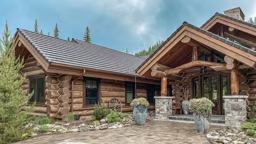 Oh, they sound so boring: structural insulated panels, or SIPs, the computer-designed-and-cut building material for walls, floors and roofs that can both structurally support and insulate your timber home. More than just an acronym and one-dimensional wall, SIPs can actually be fun. Just ask Marty Birkenkamp, design manager at Riverbend Timber Framing in Blissfield, Michigan. His eyes positively light up when describing the design possibilities, whether it’s adding depth to your facade or enhancing living space by combining panel thickess and size. So, instead of applying SIPs to typical stick-built methods that tend to be more simplified, “why not take advantage of their flexibility to create a truly unique home?” Marty asks. Here are his favorite ideas: Idea #1: Compose an Exterior Wall Devise a pretty facade for your home by adding visual interest, depth and texture to its exterior walls. One way of doing this is to combine panel length and thickness for a pilaster effect. (That’s a shallow, rectangular form that imitates the look of a column, by the way.) Idea #2: Shape Your Roof When you use SIPs for your roof, you can cut and shape overhangs so they not only have visual interest, they’ll also cast shadows on your home’s facade as the sun rises and sets. While you’re gussying up your overhangs though, be respectful of solar angles and sight lines, cautions Marty. Idea #3: Create Architectural Effects By using panels of different thicknesses, you can transform a flat facade to give the impression of a more architecturally complex structure. One way is to add a cantilever by using a SIP wall panel on the second story that’s thicker than the wall below. Idea #4: Cantilever a SIP Floor Often, we think of SIPs for walls (and roofs), but you can use them underfoot, too. Play with length to cantilever a main-level floor (much like alternating thickness to cantilever an upper-level floor.) Since all of the pieces are precision cut with computers, it’s easier to create interesting corners and lines in your home’s footprint. Idea #5: Extend an Exterior Wall You could cut down the excess length of a SIP wall to make your home’s footprint a box shape. But that’s boring. Instead of lopping off the extra length of a wall, leave it. “With the wall plane extended, you create an exterior landscape and backdrop that invites the eye toward your front door,” Marty explains. “It becomes a part of the entry that you walk along as it welcomes you inside.” |
Design Inspiration | Designing with Structural Insulated Panels
You know them as structural insulated panels. We know them better as a building material with some serious design potential that'll change the way you think about your floor plan.








_11868_2024-09-17_08-44-256x288.avif)


